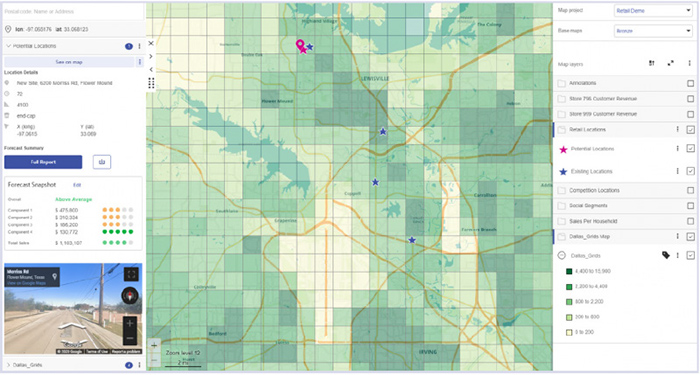eBook
Retail Channel Optimization in a World of Digital Transformation
This eBook explores how retailers rely on data science and analytics to enable decisions that bridge both the physical and digital and inform an omnichannel approach.
Overview
With rapidly evolving consumer preferences creating a groundswell of digital transformation in retail, organizations need the confidence to make better, faster decisions. This inherently means having access to trusted data which provides maximum accuracy, consistency, and context. Data integrity becomes key and this is especially true when it comes to data-driven decision making around retail site selection and channel optimization.
Site selection is the process of assessing the suitability of a potential retail location and forecasting the financial return on that investment. By leveraging objective data and unbiased retail analytics, retailers are able to model the financial performance of potential locations with a high degree of accuracy. Of course, site selection is no longer a siloed planning process, but is part of a broader channel optimization strategy which balances both online and offline opportunity.
While the “gut instinct” approach to site selection may work some of the time, particularly for smaller retailers with fewer locations, it simply cannot work at scale, and it doesn’t serve companies well when they expand outside of a familiar existing market area. For companies with hundreds or thousands of stores, a data-driven approach is essential, especially against the backdrop of a global pandemic and the planning complexities this brings. Increasingly we are seeing retailers rely on data science and analytics to enable decisions that bridge both the physical and digital and inform an omnichannel approach.

The Role of Digital Transformation in Retail Analytics
As a range of new technologies are becoming more affordable, reliable, and ubiquitous, forward-looking companies are investing heavily in digital transformation. Location intelligence and other data-driven approaches are key elements of the bigger digital transformation picture.
The retail world has seen massive changes over the past decade. Amazon Prime has redefined customer expectations around convenience, accessibility, and delivery times, with omnichannel becoming the de facto standard for most large retailers. Despite this, is it still too early to declare the death of physical retail as we know it?
Many companies like Payless, Burberry, and JC Penney have experienced a dramatic decline in revenues, ultimately leading to bankruptcy. At one time, Payless had over 5,000 stores in multiple countries, but eventually filed for Chapter 11 bankruptcy, twice. Fashion house Burberry also announced it would cut 500 jobs globally and discontinue markdowns after sales declined 45% during the first quarter of 2020.
In 2020, Payless fully embraced digital transformation, and is being reborn as a clicks-and-mortar operation, with innovative on-site components such as smart mirrors, touchscreen wall panels, and augmented reality sizing tools.
Digital transformation exists behind the scenes as well. For the retail industry, it’s playing a more important role than ever in driving innovation in analytics.


Trends in Channel Optimization
In an omnichannel world, channel optimization and site selection has fundamentally changed. Today’s customers expect a blend of digital and physical presence. They appreciate the convenience of digital interaction but they also want to have access to a person who can provide individualized attention when they need it. Businesses are embracing this expectation and as a result are able to be more resilient in the midst of volatile market dynamics. For example, in the COVID-19 lockdown periods we witnessed OSRs (On-site Retailers) able to switch to delivery and/or drive-thru offerings, while supermarkets increased delivery and ‘click and collect’ capacity. This nimble, market orientated approach is also impacting site selection plans and is being influenced by some key trends.
Mobile activity
Mobile applications have changed retail analytics and planning dramatically. Mobile devices provide opportunities for detailed data collection, enabling retailers not only to identify traffic patterns, but to understand who is frequenting a particular area, and what their consumer and lifestyle preferences are. It gives brands a view of how much traffic competitors are drawing, what kind of people they’re attracting, and how many. These data points are not only rapidly transforming new site selection, but also service delivery within those sites.
Online-only
Online-only competitors have exerted downward price pressure on brick-and-mortar retailers. This has prompted retailers to develop innovative in-store experiences to differentiate themselves and to continue attracting customers to their physical locations. This renewed focus on customer experience has been a growing trend across retail, hospitality, and financial services.

Non-traditional delivery channels
Growth and innovation in non-traditional delivery channels are having an impact as well, as companies like Uber, GrubHub, SkipTheDishes, Lieferando, Deliveroo, FoodPanda, and others are providing new low-cost options for fast and convenient delivery. Companies like Amazon are rolling out proof-of-concept programs for drone delivery. If and when such programs are implemented, they will further change consumer expectations and require retailers to adjust.
Retailers are responding to these trends by changing up their existing locations, closing some while opening new prototypes and concepts, or remodeling and reformatting existing stores. Banks, for example, have invested heavily in digital channels and have closed large numbers of branch locations over the past decade. As banks have moved away from traditional branches though, they have opened new locations built with richer, friendlier customer experiences in mind. In the same way, QSRs (Quick Service Restaurants) are adjusting their traditional store format types and are looking at smaller footprints with more focused offerings, such as take-out and drive-thru only.
The common thread throughout all of these trends is the mix of digital and physical presence. Across all demographics, today’s consumers have come to expect the best of both worlds. Decisions on physical site locations and design cannot be made in isolation; they must be made in the context of an omnichannel preference.

The Role of Data Integrity
A data-driven approach to retail site selection and channel optimization must incorporate information from a variety of sources and perspectives. However, retailers, like all businesses, struggle to trust their data for business decision making. Achieving data integrity is key – data with accuracy, consistency, and crucially, context – these characteristics are especially critical when considering the role of location data in channel optimization and site selection.
Historically, demographic data was modeled based on the residential characteristics of a neighborhood and/or daytime commercial traffic. In today’s world, that is no longer sufficient. Location intelligence provides retailers with mobile device based dynamic demographic data, enabling them to see exactly which demographic groups are frequenting an area and when.
Location intelligence also provides detailed information about site attributes, including the parcel size, availability of parking, visibility, investment history, and more. By enriching existing corporate data with location attributes and traffic data, brands can develop a holistic view of potential and existing retail locations.
Location data remains highly relevant even after the site selection process is complete, however. By tracking important changes in a location’s surroundings, retailers can receive early notification of change events that could impact store profitability and the need to optimize their channel mix. This may include the emergence of new competitors, trigger events that indicate gentrification or decline, or changes to traffic patterns and demographics.
More than ever it’s critical for all stores, branches, and restaurants to have a data-driven location intelligence strategy so that there is a continual pulse on whether to remodel, relocate, reposition, or close sites. Critical changes in consumer behavior means a continual validation of data integrity is key to informing ongoing insights. This is against the backdrop of a COVID-19 world, meaning the requirement to monitor how people are interacting with retail, and the need for contextual analytics, has intensified like never before.

Make data-driven retail decisions using location based data, highlighting micro-level consumer activity by day, time, and profile type.
The Precisely Approach
The science behind retail site selection and channel optimization involves some daunting challenges. First, it involves massive amounts of data. Second, geospatial data has unique attributes that make it fundamentally different from most data sets. Thirdly, any data utilized and relied upon for decision-making must be consistent, accurate, and have context. Finally, location intelligence requires intensive computational resources.
Precisely addresses these challenges with a comprehensive set of tools and expertise for data management, data enrichment, and location intelligence. With advanced analytics and a geospatial presentation layer, Precisely gives clients a map view of target market locations, with the ability to overlay a rich array of data elements including mobile traffic for each area, and the ability to filter that traffic based on various demographic attributes such as purchasing power, for example.
Together with the international scope of solutions and the opportunity to gain a unified and consistent approach regardless of the country, means a global location strategy is within reach. Through access
to curated data such as TomTom traffic, mobile trace digital activity, and demographic data, Precisely provides data, alongside location intelligence software, that can be leveraged to help businesses manage their real estate portfolio and optimize their channel strategy.
Five tips for optimal site selection

Collect customer transaction data:
Enrich transaction data with customer location information to create context and a solid foundation for predictive analytics.

Segment, profile, and target:
Categorize customers into segments and reveal commonalities between them. This will help you develop customer personas, identify merchandise opportunities, and uncover
new markets.

Know your competition:
Understand which competitors impact your sales the most, where they’re located and how they position their brand.

Plan your honeymoon:
Know what to expect before opening. The most successful retailers rely on data accuracy and predictive analytics to forecast how sales will progress over the first few years of operation.

Prepare for impact:
Manage net new sales and organize growth with adequate store spacing. Forecast sales transfer and open new stores with realistic expectations.
We can help you find the ideal sites for your business.